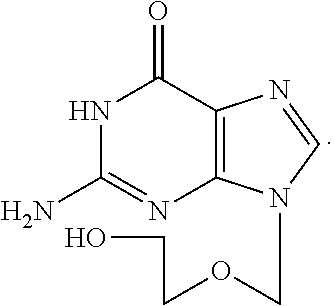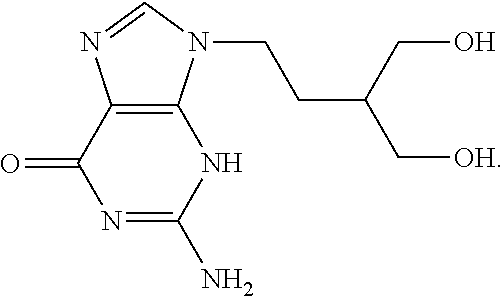Therapeutic composition to treat lesions caused by herpes simplex virus
a technology of herpes simplex virus and therapeutic composition, which is applied in the field of therapeutic composition to treat lesions caused by herpes simplex virus, can solve the problems of recurring lesions throughout the life of an infected person, unfavorable treatment of the patient, and little effect on the duration of the lesion, so as to prevent the formation of vesicles and lesion, reduce the duration of the cold sore, and prevent the appearance of cold sores
- Summary
- Abstract
- Description
- Claims
- Application Information
AI Technical Summary
Benefits of technology
Problems solved by technology
Method used
Image
Examples
example 1
[0031]In a first example, a patient presented with a lesion in the vesicle stage before any treatment had been attempted. Treatment included four applications of a compound including 2.5% ACV, 2.0% PCV, 0.2% 2-DDG, and 10% DMSO administered over two days.
[0032]The patient of Example 1 reported that the normal course of an outbreak, without treatment, would begin with a lesion in the vesicle stage and proceed to a lesion of such size that roughly half of the lip would be covered. The patient also reported significant pain associated with previous outbreaks was avoided with the treatment.
[0033]Surprisingly, post-treatment outbreaks were not observed for the duration of the follow-up period (about one year). The lack of outbreaks over such a timeframe was unusual for this patient, and it does not appear that such effective viral repression has been achieved in the past with a topical treatment.
example 2
[0034]Another patient presented with a lesion just at the beginning stages of the vesicle outbreak before any treatment has been applied (beginning of day 1). Four applications of a compound including 2.5% ACV, 2.0% PCV, 0.2% 2-DDG, and 10% DMSO were applied over the first day of treatment.
[0035]The lesion was observed to be in the healing process and erythmatous and edema was also decreased while the vesicles had also begun to dry out. The patient of Example 2 also reported a decrease in pain. Four additional applications of the compound were administered over the course of each of days 2 and 3 (eight additional applications, or twelve total). By the end of day 3, only redness was present.
example 3
[0036]A patient presented with a lesion in the prodromal stage before the vesicles have broken out and before any treatment was applied (day 1). The patient observed tingling and pain. Edema and erythmatous of the lip was also observed. Over the course of the remainder of day 1 and day 2, five applications of a compound including 3.75% ACV, 0.75% PCV, 1.0% 2-DDG, and 10% DMSO were applied.
[0037]Edema and erthymatous were lessened considerably after only one day of treatment. By the end of the second day of treatment (day 3) during which four additional applications were appllied, the lesion was virtually gone which suggests a prophylactic indication for the treatment.
PUM
| Property | Measurement | Unit |
|---|---|---|
| mass ratio | aaaaa | aaaaa |
| time | aaaaa | aaaaa |
| time | aaaaa | aaaaa |
Abstract
Description
Claims
Application Information
 Login to View More
Login to View More - R&D
- Intellectual Property
- Life Sciences
- Materials
- Tech Scout
- Unparalleled Data Quality
- Higher Quality Content
- 60% Fewer Hallucinations
Browse by: Latest US Patents, China's latest patents, Technical Efficacy Thesaurus, Application Domain, Technology Topic, Popular Technical Reports.
© 2025 PatSnap. All rights reserved.Legal|Privacy policy|Modern Slavery Act Transparency Statement|Sitemap|About US| Contact US: help@patsnap.com



